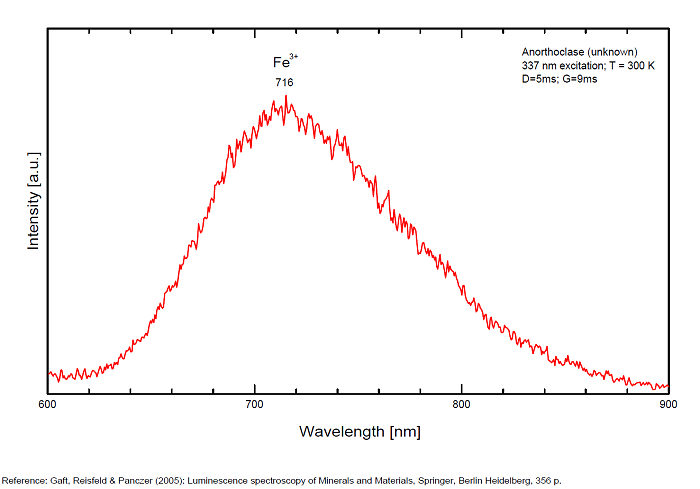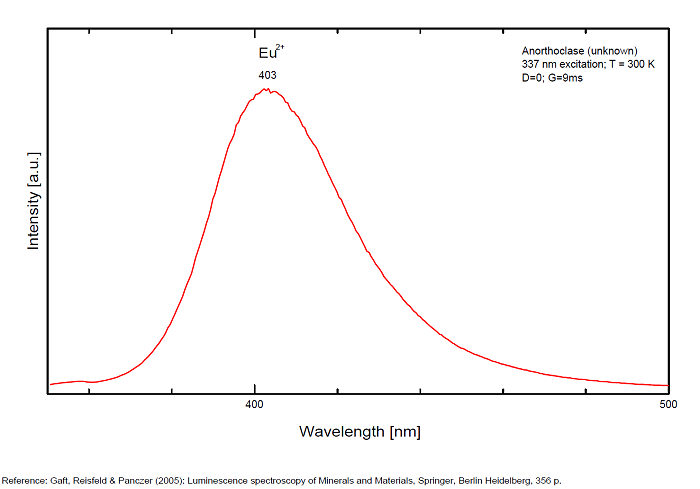Database of luminescent minerals
ANORTHOCLASE
Chemical formula: (Na,K)AlSi3O8
Family: Silicates
Status: IMA-GP
Crystal system : Triclinic
Display mineral: NON
Luminescence:
Longwave UV (365nm) colors: |
Orange , | ||
Midwave UV (320nm) colors: |
Violet , Violet , | ||
Shortwave UV (254nm) colors: |
Yellowish White , Red , Blue , | ||
Do you have a photo of this mineral you would like to see in the gallery? Contact us!
Phosphorescence (in the common sense of the term) observable with the naked eye:
No data
Activator(s) and spectrum:
Activator(s): Fe3+, Cr3+, Eu2+, Ce3+, Eu3+,
Peaks in the spectrum (nm):
Fe3+: broad bands peaking at 716nm (110nm half-width)
Cr3+(?): broad bands peaking at 785nm
Eu2+: broad band at 403nm (40nm half-width)
Ce3+: broad bands peaking at 335nm
Eu3+: 404nm

Spectrum: Michael Gaft, Petah Tikva, Israel. Plot: Institute of Mineralogy, University of Vienna, Austria, with permission of the authors.
Spectrum Galery:

 ...
...Comments on spectrum and activators:
Also broad bands peaking at 335 (Ce3+), 404 nm (Eu3+) (Gaft)
Best localities for fluorescence (*):
- Franklin, New Jersey, USA (blue SW, De Ment 1946, weak pale yellow or weak red) ;
- Mont Saint-Hilaire, La Vallée-du-Richelieu RCM, Montérégie, Québec, Canada (cherry red SW, violet MW&LW);
(*)The data are not exhaustive and are limited to a few remarkable localities for fluorescence
Bibliographic reference for luminescence:
- The Henkel Glossary of Fluorescent Minerals, Dr. Gerhard Henkel, Published by the FMS, 1989 ,
- Luminescence Spectroscopy of Minerals and Materials, M. Gaft, R. Reisfeld, G. Panczer, Springer Editor, ISBN: 10 3-540-21918-8 ,
- Handbook of Fluorescent Gems and Minerals, a practical guide for the gem and mineral collector, Jack de Ment, 1949 ,
Mineralogical reference on the Internet:
 http://www.mindat.org/show.php?name=Anorthoclase
http://www.mindat.org/show.php?name=Anorthoclase
 http://webmineral.com/data/Anorthoclase.shtml
http://webmineral.com/data/Anorthoclase.shtml
Internet Search:
 Image search on 'Google Images'
Image search on 'Google Images'
 Search for documents in all languages on Google
Search for documents in all languages on Google
A request providing no result means only that no such reference exists in the database, but it does not mean that what you are looking for does not exist, just not to our knowledge. If you think you have found an error or omission, please let us know via the contact page being sure to cite the source of information.

